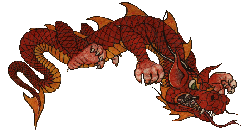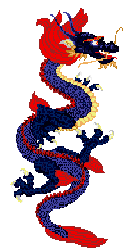

![]()
![]()
![]()
A Little Dragon History:
 Dragons have had an outstanding effect on people around the
world, but probably not more so than with the Asians. Dragons
really have not played much of a part in the Americas or in
Europe. Dragons have been stamped in many stories and fables
in the Americas and Europe, but the dragon has played a more active role
in the culture of Asians.
Dragons have had an outstanding effect on people around the
world, but probably not more so than with the Asians. Dragons
really have not played much of a part in the Americas or in
Europe. Dragons have been stamped in many stories and fables
in the Americas and Europe, but the dragon has played a more active role
in the culture of Asians.
In China the dragons were used to symbolize power, specially dragons depicted in yellow. Staircases, robes, and basically anything the Emperor owned or anywhere only the Emperor could go yellow dragons were depicted. Dragons combined with the tiger represents the heaven and earth, so the Chinese believe the two together represents power. The dragon and tiger combination with the belief of heaven and earth follows the philosophy of the Yin and the Yang. In China the dragon is known as Lung (or Long), with there being four main types:
| Celestial Dragon - | Tien-Lung | |
| Earth Dragon - | Ti-Lung | |
| Spiritual Dragon - | Shen-Lung | |
| Underworld Dragon - | Futs Lung |
Most Chinese dragons are depicted as wingless but they aren't. Allow me to explain... The dragon goes through a metamorphic transformation that takes 3000 years. Western dragons need not go through this process. The first stage of a Chinese dragon is that of a water snake. This is why they are closely related with water, especially rain. Chinese peasants worshiped the dragon so that it may bring rain. During the winter, the dragon was said to descend from the heavens to reside in the ocean. And when it came summertime, the dragon would venture back to the heavens so that the rains would return. Sometimes this would bring floods but drought was far worse because crops can't grow without water. When the dragon is done maturing, it becomes a winged dragon and is called a ying-lung.
According to Wang Fu, who lived in the Han dynasty, the Chinese dragon is drawn from 9 distinct entities:
In the Buddhist temples in Japan, dragons are used as fountain heads and as decorations. This was for the purification before their worship. The most familar type of dragon in Japan is the tatsu. Chinese dragons are closely associated with the rain, but Japanese dragons lean more to the sea. This might have to do with the fact that Japan is not as vulnerable to devastation brought on by drought as China is.
Japanese dragons are respected creatures just like Chinese dragons, not as much but they are. But there are evil Japanese dragons as well, like one fable illustrates about the dragon from Koshi. For seven years the dragon successfully devoured seven daughters from one couple alone, one daughter each year. And on the eighth year, a hero with the name of Susa-no-wo (brother of the beautiful sun goddess Ama-terasu) came. The dragon from Koshi was a eight headed beast with eight tails. In exchange for the remaining daughter's hand in marriage, Susa-no-wo promised to vanqish it ...which he did with trickery.
Even with divine status, Japanese dragons have their share of enemies as well. The fox spirits are probably the most bothersome and troubling. They carry unclean objects so that the dragons won't attack them in revenge for their trickery and evil deeds. Remember that dragons were used for purification before worship. Fox spirits also enjoy tormenting humans. Fox spirits live for a 1000 years, after which they gain 9 tails and ascend to heaven where they are wiped of their sins.
Just like the Chinese, the Japanese believe that the dragon originated in their own country. Another country that believes the dragon originated with them, is Korea. How does each country explain things?
Well it is actually quite interesting and will help you tell the difference between a Chinese, Japanese, or Korean dragon.

Since the Chinese believe the dragon originated in China, this is how they explain it. The Chinese dragons have 5 toes [left]. They say that when the dragon goes East it losses toes, and the farther it goes it losses more toes until finally it can't walk anymore. This explains why Korean dragons have 4 toes and Japanese dragons only have 3 toes. So the farther it goes, the more toes it loses. As the dragon goes West it gains toes, thereby, making harder to walk the farther West it goes as it gets more and more toes. This explains why the Asian type dragon never made it to the Americas or Europe (their dragon came much later). Its true that many of the Chinese dragons depicted have 5 toes, but it is also true they are depicted with 4 toes as well, keep that in mind. Evidently they actually began with 4 toes, but when one man was in line to become emperor and was from a lower class he needed a way to distinguish himself. He claimed he descended from dragons and claimed the Imperial had 5 toes, and anyone who was not the king but potrayed the 5-toed dragon was killed. Usually the Imperial dragon is yellow in color and shen-lung. They may have began with 4 toes but they are now depicted with 5 toes, so the above still applies. [Note: The dragon to the left is not a real chinese dragon. It is hard to find authentic Chinese dragons, and besides... this picture fits well here :-) Go to my picture page for Chinese dragons]
 The Koreans also use the toes as for one to tell
the difference between their dragon and the Chinese or Japanese.
As the dragon went East or even North the dragon would lose toes,
again making it hard for the dragon to walk. As the dragon went
West or South the dragon would gain toes making it imposible for
the dragon to go any further. The loss of toes or the gain of too
many toes didn't allow it to walk far enough to get the Americas
or Europe. As you can see, there are no conflicting stories. Well
there is one. Like the Chinese, the Koreans believe the dragon
orginated with them. So remember if you see a dragon with 4 toes
[left], then you are looking at
Korean dragon.
The Koreans also use the toes as for one to tell
the difference between their dragon and the Chinese or Japanese.
As the dragon went East or even North the dragon would lose toes,
again making it hard for the dragon to walk. As the dragon went
West or South the dragon would gain toes making it imposible for
the dragon to go any further. The loss of toes or the gain of too
many toes didn't allow it to walk far enough to get the Americas
or Europe. As you can see, there are no conflicting stories. Well
there is one. Like the Chinese, the Koreans believe the dragon
orginated with them. So remember if you see a dragon with 4 toes
[left], then you are looking at
Korean dragon.

The Japanese story follows the same guidelines as the others. The dragon has this overwhelming tendency to travel. Unfortunately it would gain or lose toes depending on which direction it went. If the dragon went East, it would lose toes. And without toes you can't walk, so the dragon only got so far. If the dragon went West, it would gain toes. And with too many toes it gets too awkard to walk. And of course this why the dragon never made it to Europe or the Americas. They too believe the dragon orginated with them. After some time, Europe did start incorporting dragons into their stories and such. Except they believed the dragon was evil, more on this down below.
The Chinese also use the dragon as part of their astrology system. Depending on the year one is born depends on what animal represents them. To the Chinese, this is a very important part of their culture. Just like some Americans use the Zodiac to state what kind of person they are, so do the Chinese with their Zodiac. Parents always wanted their children to be born a dragon person because of what the dragon represents. Because of the year I was born I am a dragon person. The dragon represents power and intelligence, we are also noted for being big mouths with a hot temper (who me?). For the best description of dragon people I suggest going here.
 Now the Western dragons are much different from
Asian dragons. Western dragons blow fire where as Asian dragon
very rarely are depicted as blowing fire. Western dragons also
have wings and as you can see from above the Asian dragons are rarely
depicted with wings (but they still can fly). Western dragons also have
big bodies where as Asian dragons have more of a serpent type of
body. Both have horns, but the Asian dragons have a antler type
of horn where as the Western dragon have more of a sadistic type
horn. Western dragons have more of wing type main (if they have
one) and the Asian dragons have more of lion's type main. Besides
"Puff the Magic Dragon," Western dragons are
mainly seen as evil and horrible creatures, and when a knight
slays the horrible creature the knight is respected. The Asian
dragons are more respected and revered; some are evil, but the
dragon is still seen as a powerful creature to be respected.
Now the Western dragons are much different from
Asian dragons. Western dragons blow fire where as Asian dragon
very rarely are depicted as blowing fire. Western dragons also
have wings and as you can see from above the Asian dragons are rarely
depicted with wings (but they still can fly). Western dragons also have
big bodies where as Asian dragons have more of a serpent type of
body. Both have horns, but the Asian dragons have a antler type
of horn where as the Western dragon have more of a sadistic type
horn. Western dragons have more of wing type main (if they have
one) and the Asian dragons have more of lion's type main. Besides
"Puff the Magic Dragon," Western dragons are
mainly seen as evil and horrible creatures, and when a knight
slays the horrible creature the knight is respected. The Asian
dragons are more respected and revered; some are evil, but the
dragon is still seen as a powerful creature to be respected.
Supposedly, the pagans saw dragons as beneficial creatures. When the Christians came, they said that dragons were that of the devil. The priests wanted to stifle any religon that wasn't Christianity. They came up with the St. George and Dragon story. For those of you who don't know the story... There was a dragon that plagued a town and took sacrifices. A hero emerged by the name of George. He slayed the beast in the name of Christianity. His actions coverted the whole town to Christianity. And thus the story went around spreading the word of Christianity while making the dragon an evil creature.
I am trying to make this page even better, so you might see some drastic changes over time.
|Dragon Info | Dragon Gallery | Dragon Links|
|Main | Mega Gallery | Babylon 5 | Kung Fu | Dragons | Links|
Copyright 1997©
E-mail: markwile@unm.edu
Old count: 28476